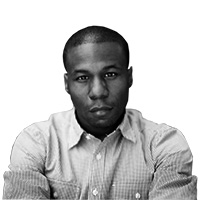On Sept. 2, San Francisco 49ers quarterback Colin Kaepernick decided to sit during the national anthem to protest police brutality and the mistreatment of black people. The following week he decided to kneel, and as his healthy head of hair blew in the wind, it dawned on American football fans: The Afro is back in vogue!
Unapologetic. Deliberate. American. Black.
Kaepernick’s Afro has sparked national interest across color and political lines, enough to make you wonder, what exactly is America’s problem with black people’s hair? Do our struggles, advances, and pains make you uncomfortable? And mind you, it’s not just a white thing. There was a time when this trend was socially unacceptable even within the black community.

In the early 1900s, Madam C.J. Walker introduced the hot comb to a people long criticized not only for the color of their skin but also for the texture of their hair, which ranged from kinky to curly to nappy. Concurrently with the flourishing of the Harlem Renaissance, both African-American men and women adopted a European sense of beauty and began straightening their hair, using a concoction mixed with equal parts shame and assimilation. The trend continued well into the late ’60s, until the civil rights movement produced a dynamic shift in cultural appreciation. Each march, each protest, from Oakland to Birmingham, signified our need to be respected wholly as a culture, including the way we dress, walk, talk, and wear our hair.
The Afro symbolizes a rejection of popular culture, ideologies, and safety. Each strand represents a grooming statement rooted in joy and greased with the pain of an exhausted community seeking hope and trying to make sense of mass executions of men of color.
But while we applaud and salute Kaepernick, especially in this #BlackLivesMatter era, none of this is new, not the look and not the protest. Child actor William “Billie” Thomas Jr., who portrayed Buckwheat in the Our Gang (Little Rascals) films, first introduced this image to mainstream white culture in the ’30s. And hair-as-protest has been around since the ’60s: think Black Power and the Panthers, and Sly Stone, and ’70s cinema’s Blaxploitation era (Shaft!), right on down to when OutKast’s Andre 3000 met Erykah Badu and released his inner ATLien, and the film Dead Presidents had everyone wearing Afro wigs as bulletproof vests. Most recently Afropunk encourages us to wrap our free-flowing, natural hair in a sound of liberty and justice for all.
In the ’90s artists associated with the genre of “Neo-Soul” produced music and sounds as kinky and wavy as their heads of hair. One of the most recognizable figures, Maxwell, became famous not only for his smooth, silky tenor but also for his massive mane. But after taking a seven-year hiatus, the crooner resurfaced sans his gorgeous crown. In an interview with Wendy Williams in May 2016, he said he wanted to “not be a haircut. I wanted to be music. I wanted to not be a gimmick, a caricature of myself.”
But the way Kaepernick flipped the script was genius: He went from rocking a low-cut Caesar to a full-fledged ’fro in a year and dared you to say anything about it.
As a former Afro aficionado (yes, I went through a phase that was equal parts Michael Evans from Good Times and Maxwell), I can testify that the hard part of an Afro is the daily maintenance. Imagine trying to go from a “School Boy Realness,” perfectly Dax coiffed and do-rag waved haircut to pre-presidential contender Jesse Jackson. It was not easy. Natural hair is high maintenance: Not only do you have to worry about perfecting the signature shape, there’s also tackling split ends, hydration, hot oil treatments, cleansing, conditioning, and most important, achieving the perfect glow with oil sheen.

To help us further understand the ins and outs of maintaining your crown, we chatted with our favorite DJ, New York City’s Legendary Chris Washington (to accord him his full moniker), whose Afro rivals that of The Roots’ Questlove. “I’ve had my Afro since I was a little boy,” he says. “It’s always been this way… may have been a little lower at times but I never went to dreads or curls or hi-top fades. So lets just put the number at 47 years LOL.”
When asked whether his hair is a political statement, Washington admitted it was all about the hair. “To me it doesn’t really symbolize anything,” he said. “It’s a hairstyle that I like and am comfortable with. Oh wait, it symbolizes me and that’s most important. And Kaepernick’s hair is gorgeous.” (So this clamor about hair could really be about fashion? Is it possible that Kaepernick’s hair is also more about vanity than anything else?)
In 1995, I knew exactly which products to purchase: coconut butter, shea butter, silicon-free conditioner, hair pick, and oil sheen. Washington agrees: “The best products are a good Afro pik, blow dryer, light hair grease, and a great barber. The Afro has to be trained and cultivated every day… so I don’t wear hats unless I absolutely have to. I will wear a visor so the hair flows through.”
Mark Kim, who runs Total Beauty Supply in Harlem, makes it even simpler: “A great shampoo, conditioner, and hair oil. That’s all you really need. Thanks to Kaepernick we cannot keep the products on the shelf. So for that I say, ‘Thank you and continue protesting.’”
Kim stocks a lot of old favorites, including African Hair Pride Oil, Ultra Sheen Men’s Afro Natural Style Lite-Crème Moisturizer, and Luster’s Multi-Look Blow-Out Kit. Maybe I will join the movement and make my Afro a street style moment for next NYFW. Would Black Twitter and Kaepernick approve?

More important, will Kaepernick continue to kneel for a greater good? Will the Afro become a national symbol that calls to a new generation to rise up and wear their groomed crowns with pride? In the words of the Legendary Chris Washington: “Wash, Rinse, Repeat, Condition!”





